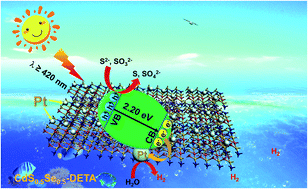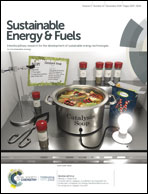Defect-mediated electron–hole separation in an inorganic–organic CdSxSe1−x–DETA solid solution under amine molecule-assisted fabrication and microwave-assisted method for promoting photocatalytic H2 evolution†
Abstract
The rapid recombination of charge carriers is always a crucial factor that influences the photocatalytic evolution of H2. In this study, an inorganic–organic CdSxSe1−x–diethylenetriamine (DETA) hybrid solid solution with surface defects was designed using DETA. With the introduction of DETA and rapid microwave solvothermal method, the electronic structure of the inorganic–organic CdSxSe1−x–DETA solid solution became well-modulated and the insufficient nucleation process resulted in the formation of surface defects. EDS, XPS and EPR analyses confirmed the existence of sulfur (S) defects. The S vacancy confined in the CdSxSe1−x–DETA solid solution can establish a vital link between the electronic manipulation and performance of the CdSxSe1−x–DETA solid solution. The sulfur vacancies can mend the vacancy structure of the CdSxSe1−x–DETA solid solution, leading to an efficient interface with low edge contact resistance. In addition, the sulfur defects can act as charge separation centers and promote the migration of photo-excited electron–hole pairs and further decline the recombination of charge carriers. Consequently, CdS0.5Se0.5–DETA exhibited higher photocatalytic activity for the production of H2 of 8.11 mmol g−1 h−1 than that of pure CdS–DETA and CdSe–DETA. This study presents a method for designing novel inorganic–organic solid solution hybrids and investigating the action of surface defects in the separation of electrons and holes. Besides, this study will give fresh insight into the design of advanced visible-light photocatalysts towards the photocatalytic production of H2.



 Please wait while we load your content...
Please wait while we load your content...